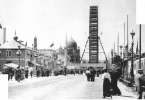Just like everyone else, what comes to my mind when it comes to Gallipoli are the lands which had become witness to a rehearsal of armageddon one hundred years ago. And then, both of my grandfathers who are buried in the nameless martyr’s cemetery of those lands.
Then what comes to my mind is the entrance of the land of Rumelia that would be the foundation of the 500-year-old “Ottoman Peace”, which the Westerners call “Pax Ottomana”… I believe it is crucial to comprehend just how those lands, in which a whole generation’s youth had fought and became martyrs a century ago, were actually made into a fatherland in five centuries ago.
The Gallipoli Peninsula is located on the European side of two of our straits that divide the continents of Asia and Europe from each other. It is difficult to travel to Gallipoli from Anatolia through natural ways; because there is a gigantic strait and the fierily galling waters. However, once you reach Gallipoli, there isn’t much of a “natural” hindrance for you to travel through to the lands of the Thrace. There is a completely flat geography almost until the Balkan Mountains… Right up until where the Istranca Mountains escarp the shores that fall parallel to the Black Sea. However, it still cannot be compared to the mountainous areas of Anatolia.
The reason why I am writing about these geomorphological details is of this: The borders of the Thrace of Turkey today – because they are more or less natural borders – also constitute the borders of the initial stages of the Rumelian conquests of the Ottomans. Although it is an era which was quite short.
The Rumelian conquests begin with the conquest of Gallipoli. As I said earlier, as soon as you pass the Çanakkale Strait and reach the Gallipoli Peninsula, your path is clear. As much as being clear in the geographical and topographical sense, it also is in the political-military sense within the conditions of the 14th century. Perhaps also because of the fact that the state, despite having a grandiose name such as the “East Roman Empire”, was suffering due to its civil strifes and economic bottleneck, it wasn’t able to protect its own land as well as the fact that it was still trying to rid itself of the old order, which had failed to provide security and prosperity to the Byzantine population…
In fact, some of the conquered towns and cities in Rumelia had actually come under the ruling of the Ottomans without fighting. Those cities, which had been conquered with a military success following armed fighting, are in fact much less in numbers compared to the others.
In fact, there is a tradition within those Ottoman cities that have survived up until today, within those cities that were conquered by the sword, the Friday congregation prayers used to be conducted with a sword in one hand. One can still come across some religious leaders giving sermons with a sword in one hand in the old Ottoman towns. Two of the very few mosques that continue to implement this tradition are located in Edincik and Gallipoli. I only mention these two because both of these two historical towns also have something else in common; Prince Suleyman, the oldest son of Orhan Gazi, initiates the preparations to conquer Gallipoli on the order of his father, from the town of Edincik. In fact, a very old plane tree located in the arena of Edincik today, is known amongst the public to be the exact tree where Suleyman Pasha had tied his horse. While there is another belief that the stake the Prince had nailed to secure his horse had taken root and a tree sprung thereof.
Edincik was first conquered by the Anatolian Seljuks and had passed into other hands a few times following the Crusades and finally, had passed onto the Ottomans from the Karesi Seigniory. As well as having a strategic position, it is logical for the Rumelia conquest preparations to have been undertaken here as it was the home to the Karesi shipyard.
Suleyman Pasha, who had been appointed by his father Orhan Bey as the ruler of the Karesi premises, had continued to pass onto the Rumelian lands with the war beys leading the veteran groups of various sizes, who were now committed to him and continued to undertake the work they were doing on behalf of the Karesi Seigniory. This “work” was to be of assistance to the friends and allies within the scope of the power struggle for the capital Byzantine.
Throughout a great part of the 14th century, the Aydınoğulları, then the Karesi and later the Ottoman Seigniory had all become involved in the struggle for power in Istanbul with alliance to the Kantakuzenos family. Once again, with the request for assistance and aid of the Kantakuzenos family, they would send their soldiers to the Rumelian lands from time to time and fight with the army of the empire. These expeditions came to such a point that they began to keep permanent soldiers at the Cinbi Fort located on the European side of the Çanakkale Strait. The Byzantines had become suspicious and had asked the Ottomans numerous times to evacuate the castle which had been given to them temporarily. The Turks ignored these calls. It was during this stage that a very violent earthquake shook the surrounding areas of Gallipoli and the walls of the castles in most areas were destroyed. Upon this, Suleyman Pasha crossed to the other side and conquered Gallipoli. Most of the research of modern historians, with Inalcık in the lead, explains the conquest of Gallipoli to have taken course in this manner.
As a result, the narrative of “the 40 heroes who made a raft from the skin of an ox they hunted one night and used to pass to the other side” mentioned within the Aşıkpaşazade and Oruç Bey histories ought to be accepted as a legend or a literary expression.
Talking of a legend, let us now talk about the unique “Strait War” by skipping 600 years at once… The story begins with the Sarıkamış Operation. This military operation which we commemorate rightfully today to have ended with such grave loss, was actually planned with great success and it is a known fact that during the initial steps, all of the plans were implemented properly, destroying the Russian army and almost taking control of the Caucasus. During the stage when the Sarıkamış Operation had cornered the Russians toward a serious qualm, the Moscow Government had requested its alliance – the British – to undertake “a military show” in the western areas in order to keep the Ottoman army away from the Caucasus fronts. London, which initially had not agreed to this request, had commenced the Çanakkale attack, once it saw the failure of the Sarıkamış Operation and during a time when the Russians had eased, using the excuse of “easing the ally Russian army at the Caucasus region”. Perhaps the reason as to why this military expedition on Çanakkale commenced, despite the opposition of the English commander-in-chief, was so that the “Allied Russia” fail to take control of Istanbul and the Straits.
Furthermore, according to the statement of Stefanos Yerasimos, the British had turned a blind eye to the passing of the Goeben and Breslau battleships through the Turkish Straits, for similar reasons. The British wanted us to have a fleet in the Black Sea, which would in return stall the “Allied Russia”, who was yearning to take control of Istanbul and the Straits. The reason for this was because it was a complete nightmare for the British to see the Russians travelling down to the Mediterranean Sea and becoming a threat to the oil regions. Hence, once the Alliance had commenced the Çanakkale Operation – in which Russia could not have been in a state to join – if Canakkale was conquered then the chance of controlling the Turkish Straits was to be lost to the British.
Winston Churchill, who was the Defence Minister acting like the spokesperson for all to these reckonings, had in fact prepared a plan of attack Çanakkale even before it went to war with the Ottoman Empire. The plan, which had prescribed the occupation of Gallipoli by the Greek army in order for the British fleets to pass through the Canakkale Strait, could not be implemented because of the doubts Greece had towards Bulgaria. After the Ottomans became a part of the war, Churchill raised the Gallipoli Operation once again but, the British War Cabinet did not approve of this plan as it would necessitate a great number of military force to be sent. Following the persistence of Churchill and his supporters, permission was granted for an operation which only involved the maritime powers.
All of the military strategy experts, including the Turkish Command-in-Chief under the leadership of Enver Pasha, believed that it would be impossible for the Çanakkale Strait to be conquered with only maritime power and without the support of ground forces. Most of the commanders of the British Army also shared the same opinion. However, they wanted to give a chance to Churchill and his friends, who had the notion that the Ottoman army could not resist such an attack.
Once the Çanakkale Operation came to an end with the loss of the Allied Navy of the British and French, the bright and prospectful political life of Churchill had been interrupted and it was only twenty five years after this event that he was able to become the Prime Minister. When it comes to Gallipoli, everyone has something to remember. What we remember is the opening of an era six hundred years ago.









Leave a Comment